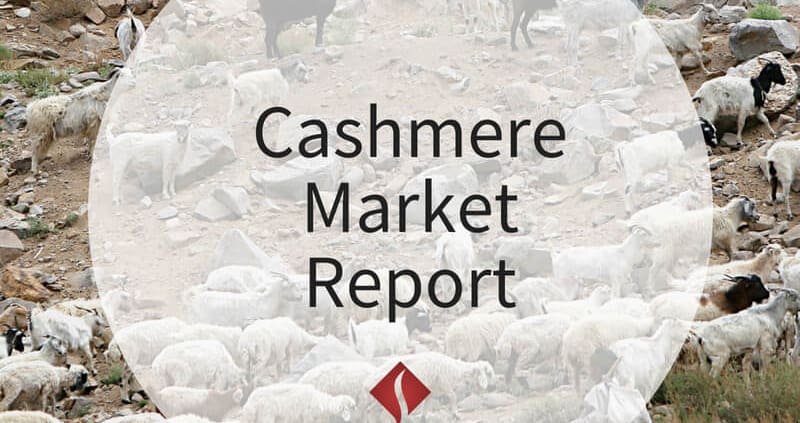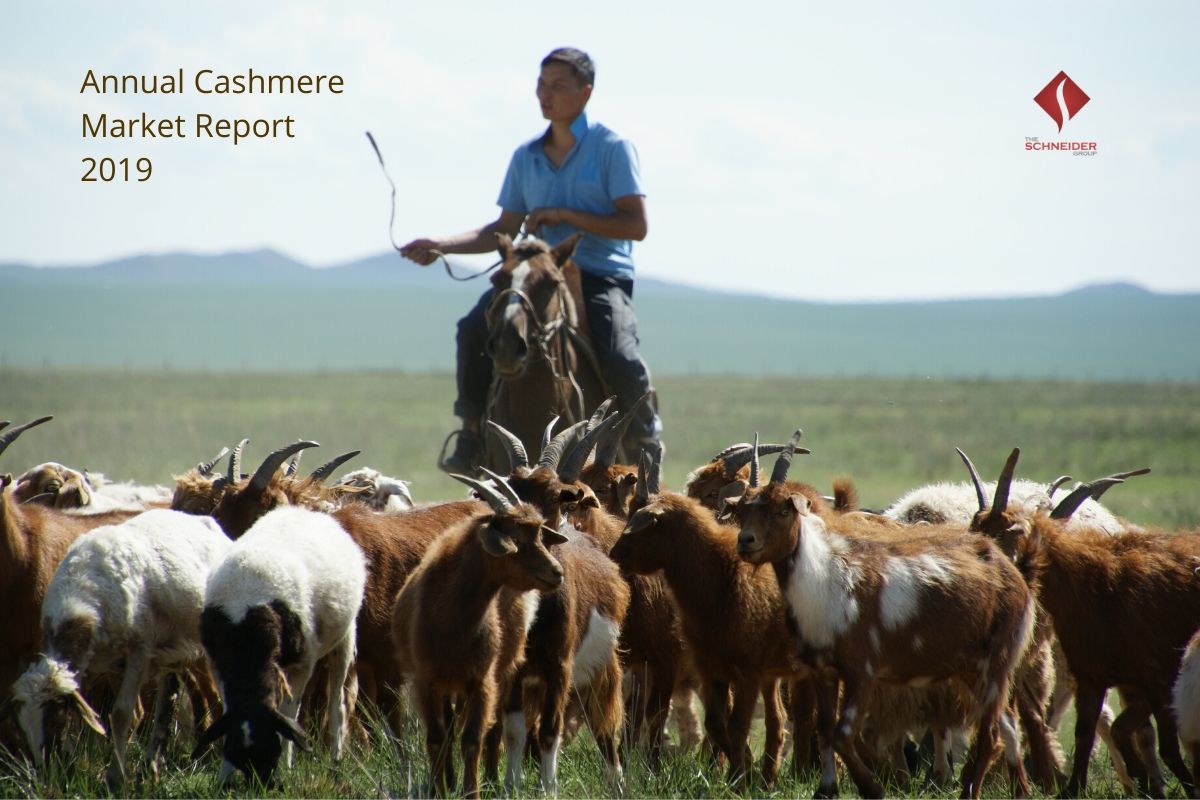ANNUAL CASHMERE MARKET REPORT 2019
CHINA
In 2019, cashmere production in China was 15.437,8 tonnes, a reduction of about 13.5% compared to 2018. Due to the decrease in demand in 2019, it is estimated that production in 2020 will be about 10% less than last year.
At the beginning of 2019, demand for cashmere was still good. With the reduction in production, the price of cashmere rose significantly in April and May in conjunction with the arrival of the new season. From June to July tariffs were increased due to the Sino-American trade war.
In addition, in 2019 the price of lambs rose by about 15% to 18%, which led to a further reduction in cashmere production.
Starting in August, demand for cashmere decreased significantly, leading to a reduction in prices until the end of the year. Most Chinese factories have ceased production.
Overall, the average price of cashmere in 2019 fell by around 12% compared to 2018.
From January to June 2019, China exported 1.331 tonnes of cashmere, an increase of 8.3% compared to the same period in 2018. Total turnover was USD 98.228.000, an increase of 9.1%. However, from June to November, 2.630 tonnes of cashmere were exported, a decrease of 10.2% compared to 2018. The total amount was USD 129.156.000, a decrease of 8.9% compared to 2018.
For the next season, all factories should return to regular operation only from March due to the Coronavirus problem. If demand returns, prices may rise again, especially for fine/beautiful types.
MONGOLIA
The extreme winter conditions and the dry winter of the Mongolian territory have caused extensive losses of livestock, despite which the shepherd communities have tried to survive as much as possible. As there is no rain, the wind dries the grass and the animals are leaner than usual.
According to the Mongolian statistical office, there are about 70.9 million heads of livestock in Mongolia. In 2019 the total number of cashmere goats reached 29 million, equivalent to about 9.800 tons of greasy cashmere, compared to 27 million goats in 2018, equivalent to about 9.400 tons of greasy cashmere. The price of greasy cashmere increased by 28% compared to previous years. The cashmere industry is expected to grow by 3.9% per year for the coming years.
Last year, Mongolia produced 8.066 tons of clean cashmere (90% of total cashmere production) which was mainly exported to China and 408.5 tons of dehaired cashmere (the equivalent of 817 tons of greasy cashmere). The main importers of dehaired cashmere were Italy with 342 tonnes, England 46.3 tonnes, Germany 3.8 tonnes, India 5.1 tonnes, and other countries 11.3 tonnes. 90% of the whole production was first-stage processing, with final product manufacturing only accounting for 10%.
In spring 2019, Mongolian cashmere shepherds sold their cashmere at 145.000 MNT/kg (54.70 USD/kg), almost 40.000 MNT (15.00 USD/kg) more than in 2018 prices. In 2019, the cashmere season in Mongolia opened with very high prices of 54-55$/kg, although the market in Europe was relatively quiet.
Both Mongolian and Chinese traders hoped that prices would remain as high as in 2018. The strengthening of the RMB gave Chinese traders the opportunity to get cashmere at a reasonable price.
Unfortunately, from June/July 2019 prices fell due to European market demand, Chinese market consumption and the Sino-American trade war. Macroeconomic factors also had a substantial impact on the cashmere industry: labour costs, tax rates, interest rates, and exchange rates.
In the future, the Mongolian government will promote value-added products for export.
On July 26, 2018, Representative Ted Yoho and nine other members of the US House of Representatives delivered a trade bill to the US Congress. The bill would seek to promote trade between the United States of America and Mongolia by allowing duty-free trade for certain imports from Mongolia, such as cashmere products and textiles.
In connection with the trade bill, Mongolian President Battulga Khaltmaa visited the United States on 31 July 2019. During the visit, the Mongolian President expressed his full support for the trade bill and his appreciation to the sponsors.
The trade act would help the Mongolian economy to open more business opportunities to export cashmere products to the U.S. market. Mongolia supplies about 48% of the total greasy cashmere to the world market, making the country the second-largest supplier of greasy cashmere in the world, but uses only 15% of it to produce ready-to-use finished cashmere garments locally.
The remaining 85% of greasy cashmere is sold as semi-finished products to other markets with lower added value, which is becoming the focal point of the Mongolian government and domestic cashmere producers.
The United States of America is considered the second-largest consumer of finished cashmere garments. This duty-free treatment would open up a huge opportunity for Mongolia to diversify its economy.
MIDDLE EAST
For Iranian cashmere, the year 2019 started with predictions of price increases similar to the previous year. However, most traders ignored or preferred to ignore, that any price increase in 2018 was due to strong fluctuations in the value of the local currency against international currencies, caused by the economic sanctions imposed on Iran by the Trump administration.
The value of the local currency halved during 2018, and in some periods it even lost two-thirds of its starting value. The cashmere market was not so rigid in 2018, so Chinese traders took the opportunity to use their expensive dollars and rushed into the Iranian market. The result was an increase in the price of Iranian cashmere at a rate of 400% in local money but only 50% in USD.
In 2019, the international cashmere market began to collapse with prices falling sharply, again perhaps due to the sanctions imposed by the United States on many Chinese goods.
Chinese traders have not been seen often on the market this year if not only occasionally and only to test the market in Iran. The local currency has also reached a stable level. Therefore, both factors that generally influence the rise in prices have been absent.
Although once again there have been ups and downs in the value of the local currency, the market has seen a stable price structure in terms of both Rials and USD throughout the year.
Traders, who had bet on price increases, bought large quantities at high prices and were unable to dispose of their stocks.
As a result, not much was sold last year and a lot of stock has been maintained for 2020, but the price is still high. This has caused Iranian cashmere to lose its market and there is not much hope for the new season unless the arrival of the new shear in April forces traders to start selling their leftovers at a loss to stay in the game.
Again, much will depend on Chinese traders and also on the devaluation of the local currency, although it now seems stable, the tighter sanctions envisaged could lead to further devaluation and again to a sharp rise in cashmere prices in Iran.

 The Schneider Group
The Schneider Group
 The Schneider Group
The Schneider Group The Schneider Group
The Schneider Group
Leave a Reply
Want to join the discussion?Feel free to contribute!